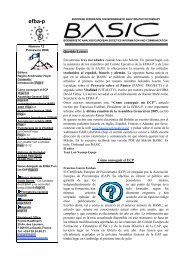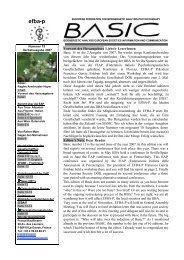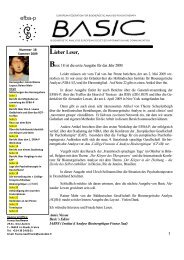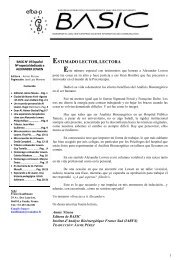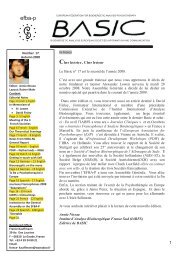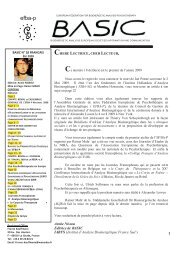December 2004 - European Federation for Bioenergetic Analysis ...
December 2004 - European Federation for Bioenergetic Analysis ...
December 2004 - European Federation for Bioenergetic Analysis ...
You also want an ePaper? Increase the reach of your titles
YUMPU automatically turns print PDFs into web optimized ePapers that Google loves.
demonstrating a statistical valid relationship between body reading and character structure<br />
(Koemeda-Lutz 2001, Koemeda-Lutz & Peter 2002; Koemeda-Lutz, Peter & Emmenegger<br />
2003c).<br />
1.5. Practice<br />
BA is a <strong>for</strong>m of psychotherapy where two languages are combined: the verbal and the body<br />
language. Verbal language does not need explaining, but body language possibly does. We<br />
distinguish between so-called “exercises” and bodily interventions. Lowen (Lowen & Lowen<br />
1979) and several followers (Sollmann 1988; Dietrich & Pechtl 1991) have described physical<br />
“exercises” the purpose of which is to gain a better consciousness of one’s body and its parts,<br />
especially those parts which are tense, but also to feel more alive, as Lowen called it, more<br />
vibrant. Some exercises are intended to bring a person more to his feet, to feel the ground,<br />
others to help him to feel freer. Ultimately the effect is that the patient is also more sensitive<br />
and open to feelings like sadness, anger, fear, despair etc. and dares to show them. These<br />
exercises can be offered to a patient during a therapeutic session or as some therapist<br />
colleagues do it, they offer exercise classes. There exist such classes <strong>for</strong> children in Rome<br />
(Pantanelli & Maiello 2001) where they can improve their self-confidence and assertiveness.<br />
A bodily intervention is different: here we may mirror a certain gesture or facial expression or<br />
suggest taking up a stress position or even a cathartic movement, this with the idea to bring<br />
out the hidden feeling that we therapists noticed. There exist many case vignettes reporting<br />
such interventions (see the books by Lowen) and also a number of complete case histories<br />
with explicit details of such interventions (Ventling 2001, 2002).<br />
2. Please provide evidence that your approach has demonstrated its claim to knowledge<br />
and competence within its field tradition of diagnosis/assessment and of<br />
treatment/intervention.<br />
<strong>Bioenergetic</strong> <strong>Analysis</strong> is represented by training institutes and therapists practising in<br />
numerous <strong>European</strong>, North and South American countries and New Zealand. The training is<br />
organised by national or local training institutes according to the curriculum of the<br />
International Institute of <strong>Bioenergetic</strong> <strong>Analysis</strong>. The co-ordinating trainers must be members<br />
of the international faculty. Additional subject matters may be taught by local trainers.<br />
The training lasts from 4 to 5 years, with a minimum total of training days of 75 to 80.<br />
Teaching is done by means of experiential learning, reflection and theoretical instruction.<br />
5



